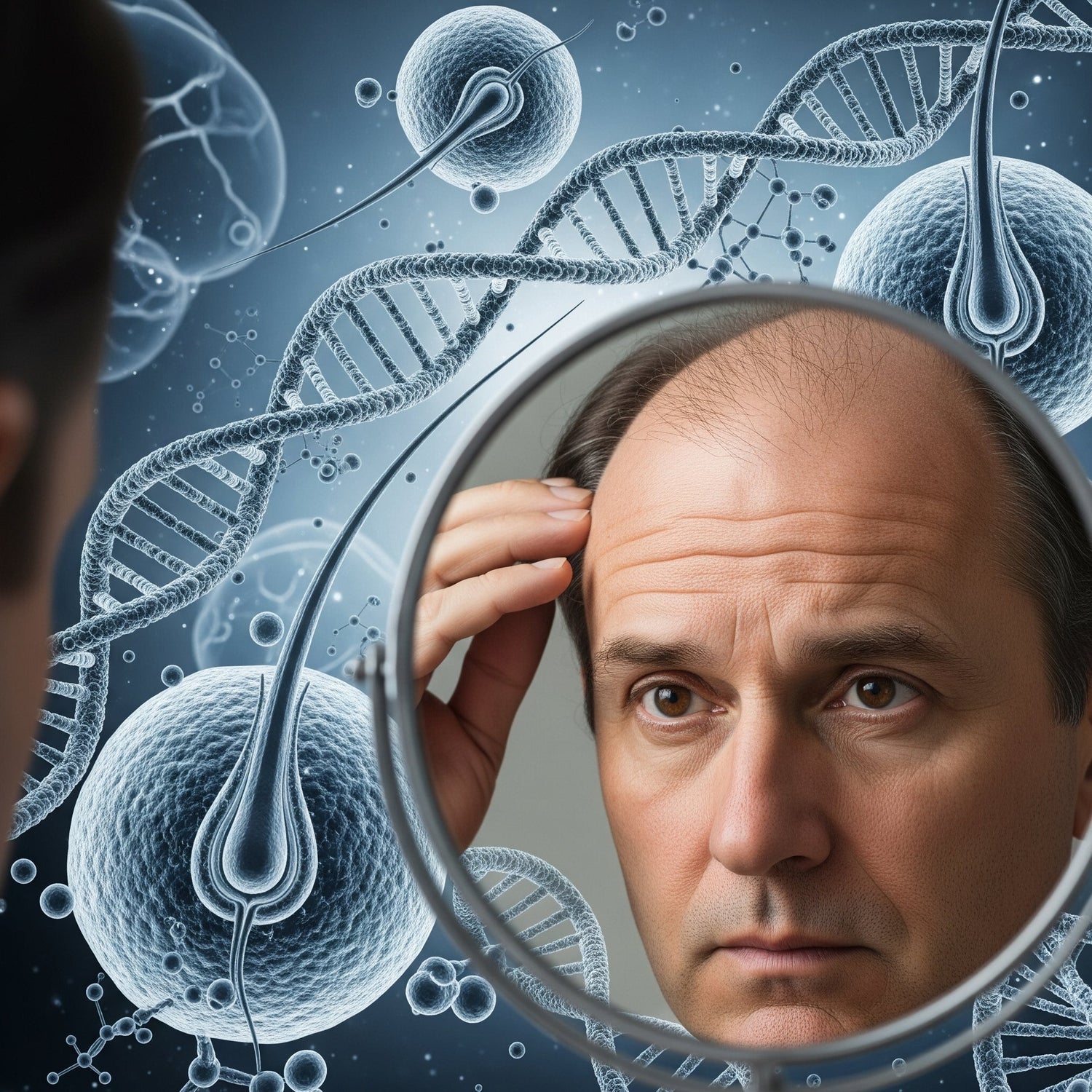Baldness types, causes and effective solutions
From genetic causes to new treatments: a complete guide to facing baldness without panic.
Baldness is a condition that affects millions of people worldwide, representing one of the main aesthetic and psychological concerns. It can manifest in different forms and for multiple causes, often interconnected. Let's explore the topic and the available solutions together.
Differences between baldness and thinning
Although the terms baldness and thinning are often used as synonyms, they refer to different phenomena.
Thinning is characterized by a progressive reduction in hair density, with hair becoming increasingly finer, fragile, and less numerous. It is a condition that can be temporary and reversible, especially if recognized and treated early.
Baldness, on the other hand, is a marked and often permanent hair loss caused by inactivity or permanent miniaturization of hair follicles. In baldness, there is a partial or total absence of hair in certain areas of the scalp, particularly in the frontal, parietal, and vertex regions. It is a phenomenon that affects men more, although it is not absent in women either.
Unlike thinning, which can be linked to temporary factors such as stress or nutritional imbalances, baldness has a genetic and hormonal origin.
The main forms of baldness: male, female, early
Baldness can manifest in different forms, varying according to sex, age, and genetic predisposition.
Male baldness is the most common. Also known as androgenetic alopecia, it presents with a receding frontal hairline and progressive loss in the vertex area. It is mainly caused by the action of dihydrotestosterone (DHT), a hormone derived from testosterone, on genetically predisposed hair follicles. It can begin during adolescence and progress over the years, leading to significant hair loss.
Female baldness, although less evident aesthetically, is equally significant. In women, hair loss occurs in the upper part of the scalp, while the frontal hairline usually remains unchanged. The causes are often linked to hormonal imbalances, including those occurring during menopause, after childbirth, or in the presence of endocrine disorders (polycystic ovary syndrome). In this case too, the genetic component plays a fundamental role.
Furthermore, early baldness is when hair loss occurs before the age of 25-30. It can affect both men and women and often has a significant psychological impact, given the young age of those involved. It is advisable to intervene promptly to slow progression and evaluate the best available remedies.
Genetic, hormonal and environmental causes of baldness
The causes of baldness are multiple and often influence each other over time. The three main factors are genetic predisposition, hormonal alterations, and environmental or lifestyle-related elements.
Genetics is the main determinant of androgenetic baldness. Hair follicles in predisposed individuals respond abnormally to the action of androgens, particularly DHT, which accelerates the hair life cycle and leads to follicular miniaturization. If there are cases of baldness in the family, the likelihood of being affected is high.
Hormonal factors are closely linked to baldness, especially in males. Excess DHT causes progressive weakening of follicles, reducing the quality and duration of hair growth. In women, variations in estrogen and androgen levels can alter normal follicular activity.
Environmental causes include chronic stress, a diet poor in essential micronutrients (iron, zinc, B vitamins), pollution, excessive use of harsh cosmetics, and smoking habits. Autoimmune diseases, scalp infections, and certain medications can also contribute to hair loss.
Combining these factors provides a complete view of the condition's origin, useful for finding the cure for baldness thanks to the cosmetic solutions for thinning hair available.
Available treatments: drugs, transplant, cosmetics
Treatments for baldness are multiple and should be chosen based on the severity of the condition, patient expectations, and individual response. The main approaches include drugs, surgical interventions, and cosmetic solutions.
Among the drugs, the most used are:
· Minoxidil: a topical drug that stimulates scalp microcirculation and prolongs the hair anagen phase. It is indicated for both male and female baldness;
· Finasteride: an oral drug reserved for men, it acts by inhibiting the enzyme responsible for converting testosterone into DHT. It must be taken under strict medical supervision due to the possibility of side effects.
For those seeking a permanent solution, hair transplant represents one of the options to consider. Modern techniques, such as FUE (Follicular Unit Extraction), allow the extraction of single follicular units from the donor area and reimplantation in bald areas. The results are natural and long-lasting, although a thorough preliminary evaluation is necessary.
On the cosmetic front, there are several less invasive remedies for baldness, useful for improving aesthetic appearance without medical interventions. Among these, fibers suitable for dark hair thinning can be considered, which help optimally mask thinning areas. Some experts recommend adjunct treatments such as PRP (platelet-rich plasma), mesotherapy, or microneedling to stimulate still active follicles.
It is important to choose the treatment suitable for one's needs, relying on experienced doctors and avoiding do-it-yourself solutions lacking scientific validation.
Tips for living with baldness
Living with baldness can be a challenge, especially psychologically. The impact on personal image is often significant, and there are effective strategies to face the situation with balance and confidence.
Accepting one's condition is the first step, as baldness is a common characteristic that does not compromise personal or professional value.
Many men and women choose to live peacefully with hair loss, adopting a style that enhances their image through suitable haircuts, complete shaves, or the use of accessories that become satisfying aesthetic solutions.
It is useful to seek psychological support, especially in cases of early baldness or in individuals particularly affected emotionally. Talking with a specialist or sharing experiences with others going through the same can provide concrete help to reduce anxiety and improve self-esteem.
Today, the cure for baldness is increasingly personalized, with concrete and safe results, provided one relies on qualified professionals.


